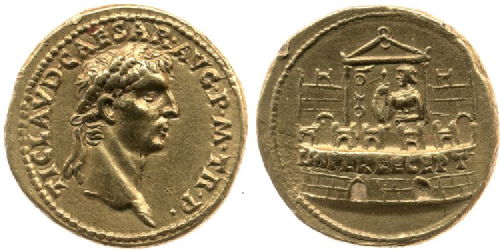All 2 entries tagged Aureus
No other Warwick Blogs use the tag Aureus on entries | View entries tagged Aureus at Technorati | There are no images tagged Aureus on this blog
January 01, 2016
Numismatics: the role of the Praetorians in the accession of Claudius
 |
RIC I2 Claudius 7
Date: AD 41 - AD 42
Denomination: Aureus
Mint: Rome
Obverse: TI CLAVD CAESAR AVG P M TR P (Tiberius Claudius Caesar Augustus, Pontifex Maximus, Holder of Tribunician Potestas). Head of Claudius, laureate, right.
Reverse: IMPER RECEPT (Imperator/Emperor Received). Battlemented wall enclosing praetorian camp; inside, soldier, holding spear, right; in front, aquila; behind, pediment with flanking walls.
Claudius rose to the position of Emperor in AD 41, after the assassination of Caligula in a conspiracy including the Praetorian commander Cassius Chaerea. Suetonius writes that a terrified Claudius took refuge by hiding in the palace (Josephus, Antiquities of the Jews 19.3). Claudius was found by the Praetorians, carried to their camp, and it was here that Suetonius reports Claudius spent the night in terror. On the following day the Praetorians chose to swear allegiance to Claudius as their newly elected emperor.
With this knowledge the coin takes on a completely different meaning from first glance, and gains far more significance (Crawford (1970) 265). It explains the iconography on the reverse of the coin, portraying the Praetorian camp, where Claudius was sworn in as emperor. The image behind the wall represents a Praetorian soldier holding a spear standing beside an aquila or “standard”. This offers an insight into the strong relationship between the Praetorian Guard and Claudius. This coin perfectly captures the change in attitude of Claudius, from Suetonius’ description of him fearing for his life at the hands of the Praetorians to instead displaying them as a symbol of safety, security and prosperity.
The Praetorian Guard, however, is shrouded by controversy in modern studies. Overall, they have received relatively little scholarly attention, yet it is almost unanimously accepted by scholars that the Praetorian Guard were used in supporting emperors’ often “ruthless” regimes (Rankov (1994) 3). This is an idea furthered by Levick’s reading of Josephus’ account, that the senate considered Claudius had seized the position of Emperor, condemning him in their eyes as a hostis or “public enemy” in much the same way as Mark Antony after the battle of Actium (Levick (2015) 40). However, with the support of the Praetorians the senate had little choice but to accept Claudius as Emperor. The power of the Praetorians is evident in this historic narrative and neatly summed up in Josephus when Veranius and Brocchus beseech Claudius not to accept the Praetorians’ backing in taking the position of emperor:
Now these ambassadors, Veranius and Brocchus, who were both of them tribunes of the people, made this speech to Claudius; and falling down upon their knees, they begged of him that he would not throw the city into wars and misfortunes; but when they saw what a multitude of soldiers encompassed and guarded Claudius, and that the forces that were with the consuls were, in comparison of them, perfectly inconsiderable, they added, that if he did desire the government, he should accept of it as given by the senate; that he would prosper better, and be happier, if he came to it, not by the injustice, but by the good-will of those that would bestow it upon him.
Josephus Antiquities of the Jews 19.4
There are clear parallels with Claudius’ rise to the position of emperor and that of Julius Caesar’s: both relied on strength of arms, although seizing power could arguably have brought great danger to Claudius. The speech of Veranius and Brocchus also draws a comparison of Claudius with “former tyrants” who had caused great afflictions to their cities (Josephus, Antiquities of the Jews 19.3). It would be easy to assume Claudius would want to distance himself from being seen as too powerful, something that may have contributed to the assassination of Julius Caesar. However, it is incredibly interesting that Claudius does not attempt to obscure the way he came to power; rather he advertises the support of the Praetorian Guard on pieces that include this coin (Levick (2015) 43-4).
The motive of the Praetorians becomes clear when we look at Suetonius, who explains that Claudius was the first Emperor to purchase the submission of the soldiers with money, promising fifteen to twenty thousand sesterces to each member of the Praetorian guard (Suetonius, Claudius 5.10). Tacitus mentions that the Praetorians rose in number from 9 to 12 cohorts in AD 47. Each cohort comprised one thousand soldiers; so assuming nine thousand soldiers at fifteen thousand sesterces each, Claudius would have been giving in the region of 135 million sesterces. The enormity of this donation may also have had a profound impact on the Urban cohort, undermining their loyalty to the senate through a sense of envy (Levick (2015) 37). Yet many coins minted at the beginning of Claudius’ reign in AD 41/42 display extremely similar iconography and it is easy to assume that a large number of these coins would end up in the hands of the Praetorians. This seems to be a clever reminder from Claudius to each soldier of the importance of the Praetorians to his rule, and a somewhat subtle attempt to avoid a similar ending to Caligula.
Here we have a perfect example of an emperor who clearly owed his rule to the praetorians and by examining the coins and literary sources there can be no doubt about the significance of the Praetorian Guard in this episode of Roman history.
 |
This month's coin was written by Miles Pearce. This is his first year at Warwick; he previously read Classics and Ancient History at Lampeter University. He is currently studying Ancient Visual and Material Culture at Masters Level, and so far has found a particular interest in reception of Greek myth in Renaissance art. However, his main interest is the Praetorian guard and their political influence.
Bibliography
July 01, 2014
Coin of the Month: Two Coins Depicting Germania
 |
| Gold coin of Domitian showing Germania |
In 83 AD the Emperor Domitian (81-96 AD) conducted a campaign against the Germanic tribe of the Chatti, the first emperor to campaign in person since Claudius’ expedition to Britain in 43 AD. Literary tradition is divided over the success of campaign; Iulius Frontinus commended Domitian’s strategy and handling of troops, but other sources suggested that the Chatti were not subdued and continued to pose a threat, even if defences of the frontier were improved. In any case, Domitian proclaimed a victory and had this magnificent aureus struck in Rome around 84 AD. The obverse shows a laureate head of Domitian facing left, wearing an aegis. The legend overhead reads IMP(erator) CAES(ar) DIVI VESP(asiani) F(ilii) DOMITIAN(us) AUG(ustus): ‘Emperor Caesar Domitian Augustus, son of the divine Vespasian’. The reverse depicts a humbled and sorrowful semi-naked female figure sitting on a beautifully embossed shield. A broken spear can be seen underneath. The inscription overhead proclaims Domitian’s title of victor of the Germans: GERMANICUS CO(n)S(ul) X.
 |
|
Gold coin of Trajan showing Germania © The Trustees of the British Museum |
The depiction of Germania in the second coin is very different. This coin is an aureus struck in Rome in 98-99 AD. The obverse displays the laureate head of Trajan (98-117 AD) facing right, with the legend IMP(erator) CAES(ar) NERVA TRAIAN(us) AUG(ustus) GERM(anicus): ‘Emperor Caesar Nerva Traianus Augustus Germanicus’. The reverse bears the words PONT(ifex) MAX(imus) TR(ibunus) POT(estas) CO(n)S(ul) II: ‘chief priest, holder of tribunician power, consul for the second time’. It depicts Germania seated on a pile of shields, resting her left arm on a hexagonal shield and holding an olive branch in the right hand. The pile of shields and the olive branch suggest the end of confrontation. At the same time, the semi-naked proud figure of Germania reminds the viewer of Tacitus’ descriptions of hostile, free, ‘barbaric’ Germanic tribes. So instead of depicting a conquered Germania like in Domitian’s coin, Trajan’s aureus presents Germania as a barbarian nation making a pact with Rome under the paternal gaze of the emperor. In this way the second coin also advertised Trajan’s successful tenure as governor of Germania before he succeeded his adoptive father Nerva in 98 AD.
 This month’s coin was chosen by Desiree Arbo, a second year PhD student. Desiree’s research focuses on the reception of classical texts in 18th-19th century Spanish America. She is currently exploring how Jesuit missionaries used classical themes and texts to depict the Guarani Indians of Paraguay.
This month’s coin was chosen by Desiree Arbo, a second year PhD student. Desiree’s research focuses on the reception of classical texts in 18th-19th century Spanish America. She is currently exploring how Jesuit missionaries used classical themes and texts to depict the Guarani Indians of Paraguay.
(Coin of Domitian above reproduced courtesy of Numismatica Ars Classica NAC AG (Auction 67, lot 139)
 Clare Rowan
Clare Rowan

 Please wait - comments are loading
Please wait - comments are loading

 Loading…
Loading…

